Tulip Time Cruise
By Katherine Rodeghier
After a cold winter, I anxiously await welcoming signs of spring: the first robin, more daylight hours, flowers poking their heads from bulbs growing in slowly warming soil. I especially look for my favorite — tulips — and found an eye-popping display inside the gates of Keukenhof Gardens outside Amsterdam.
Seven million flowering bulbs cover its 80 acres, most of them the kings of Keukenhof, tulips in a kaleidoscope of colors running riot in serpentine flower beds, mounds of blooms, rows of bright, upright stems reflected in pools and canals.
It was the shore excursion I and my fellow flower lovers aboard AmaSerena had been waiting for during our AmaWaterways Tulip Time cruise on the rivers and waterways of Belgium and the Netherlands.
Awash in Blooms
While Keukenhof came on the last day of my week-long cruise, I enjoyed spring flowers when I first stepped aboard AmaSerena. Overflowing vases of tulips lined the reception desk and bar. After his welcome over cocktails on embarkation evening, a smiling Captain Eddy Poppema handed out tulips to the ladies as we headed to the main restaurant for dinner.
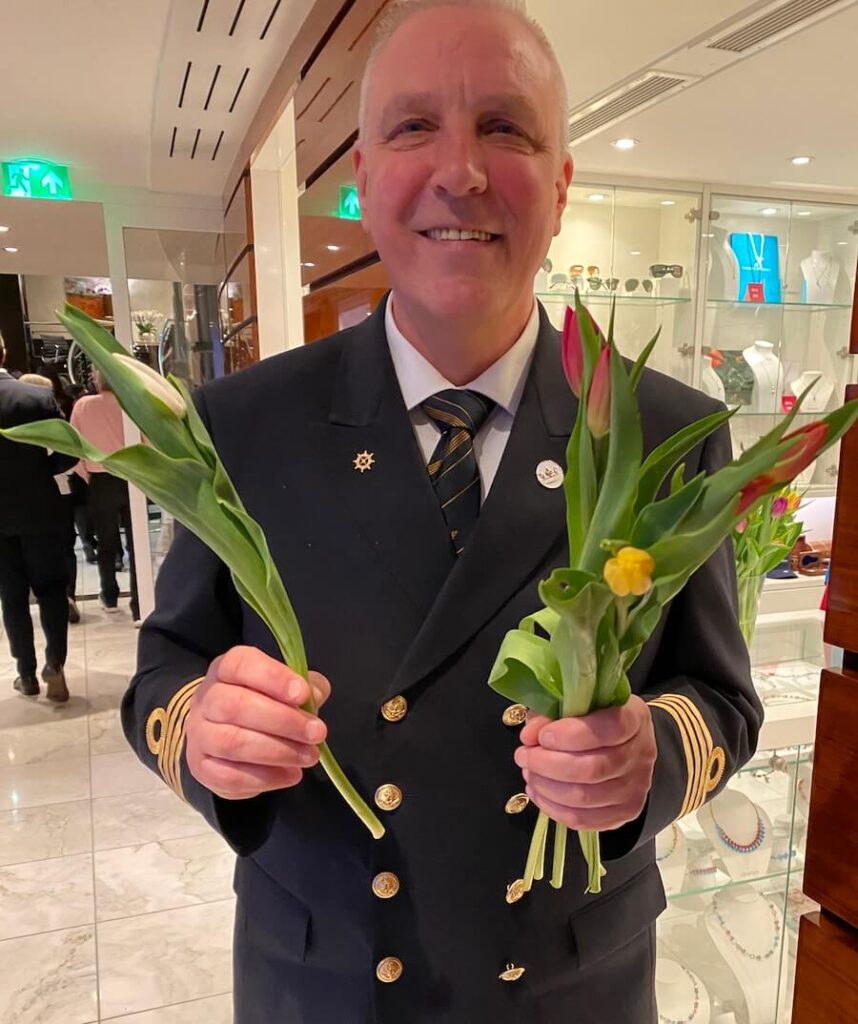
Captain Eddy Poppema handing out tulips to female passengers. * Photo: Katherine Rodeghier
In each port, bright blooms punctuated the landscape, but mostly yellow daffodils.
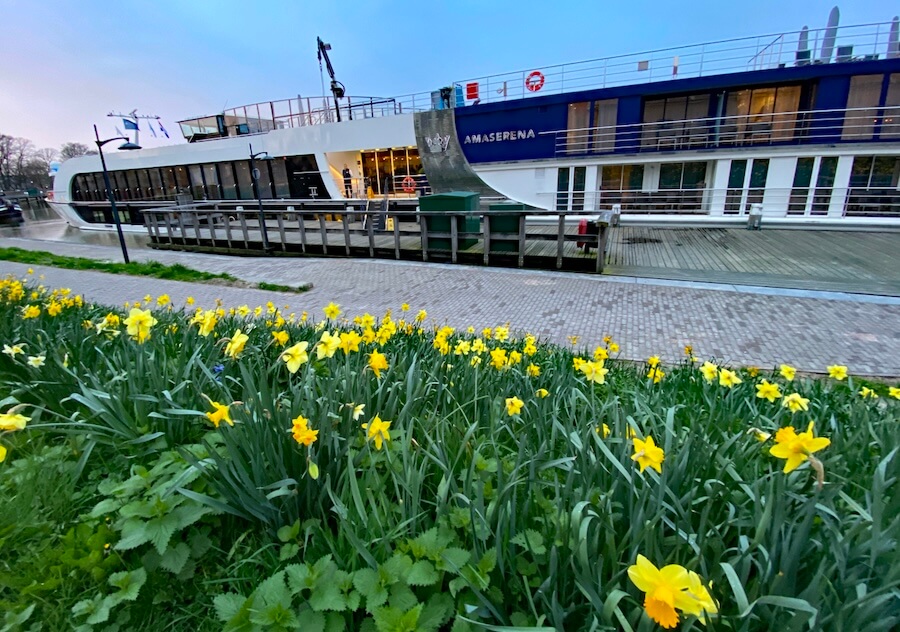
The 162-pax AmaSerena with daffodils in Middelburg. * Photo: Katherine Rodeghier
Because I was aboard an early-season departure, March 21, tulips were still a week or two away from fully emerging in local gardens. Keukenhof, however, was ready with tulips galore when it opened March 24.
Forty gardeners plant three layers of bulbs in flower beds, a technique it calls “lasagna planting,” to ensure something is always in bloom.

Tulip beds at Keukenhof. * Photo: Katherine Rodeghier
Subscribe to our monthly small ship cruise email
Subscribe to QuirkyCruise.com for monthly curated newsletters highlighting our top small cruise ship reviews, round-ups & offers!
Visiting a Tulip Farm
I had a behind-the-scenes look at tulip agriculture on a shore excursion to Pronk Tulpen B.V., a third-generation family farm outside our first port, Hoorn. Colinda Schipper, partner of one of the Pronk sons, led our group through the greenhouses where tulip bulbs are bred in water, not soil. For sustainability, the farm uses a closed water system and solar panels for electricity, she said.
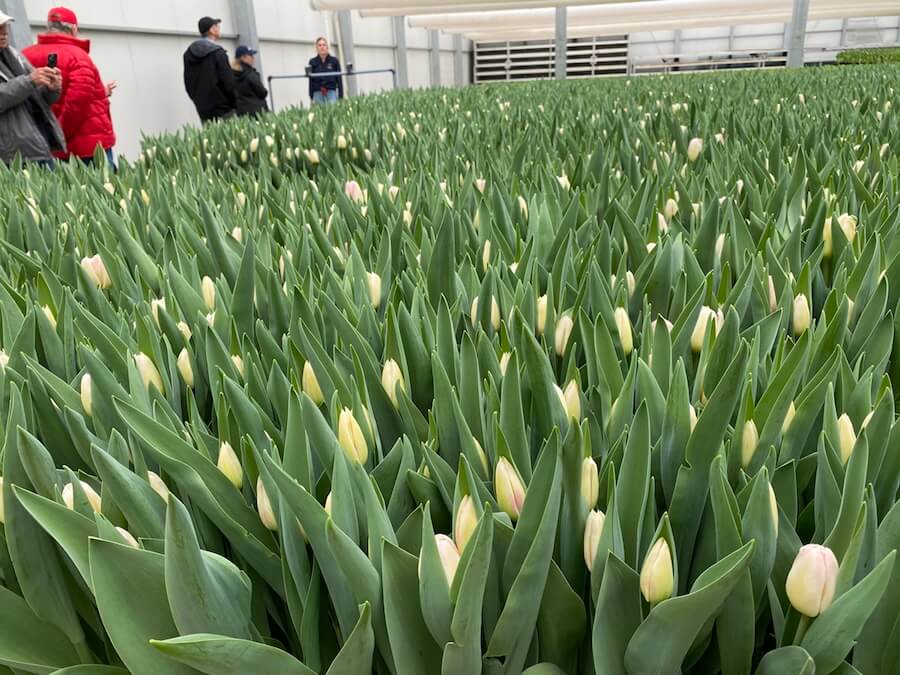
Touring a tulip farm greenhouse. * Photo: Katherine Rodeghier
During a video explaining how tulips are grown in fields, I joined in a collective gasp when heavy machinery was shown unceremoniously mowing down rows of colorful blooms like crops in a Midwest farm field. This is done to make the bulbs grow larger, Schipper said.
Pronk is a mid-size grower producing 25 million tulips per year; larger growers turn out 50-80 million.
As a whole, the Netherlands produces 10 billion tulip bulbs annually, 70 percent of the world’s output, with most going to the U.S. and Japan.
Every year growers introduce new varieties, sometimes named for celebrities or dignitaries. On International Women’s Day in 2024, a deep pink tulip was christened “Tulipa Shefali” for the U.S. ambassador to the Netherlands Shefali Razdan Duggal. She is the first ambassador from any country to be given the honor.
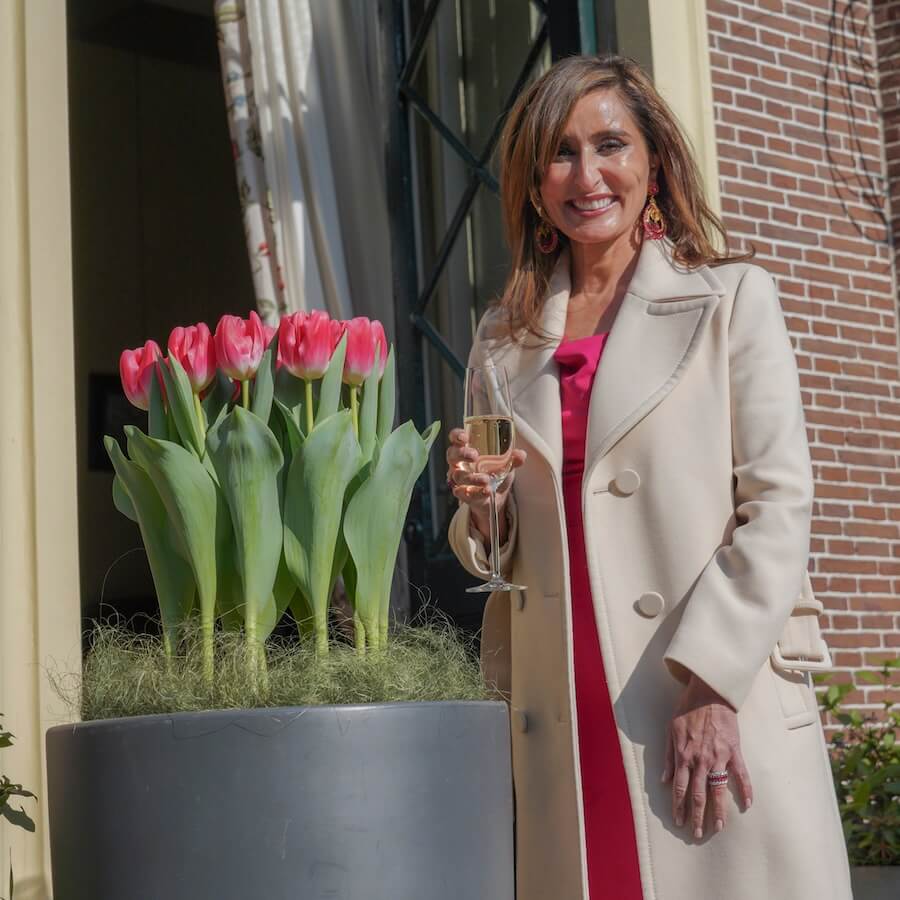
U.S. Ambassador to the Netherlands Shefali Razdan Duggal at Keukenhof for the 2024 naming of a tulip variety for her. * Photo: Keukenhof
Tulip Mania on a Tulip Time Cruise
Tulips are not native to the Netherlands. A local guide explained they originated in Central Asia and spread to Turkey where the flower was named for the shape of turbans worn there. A Dutch diplomat brought bulbs to the Habsburg court in Vienna in the 16th century and a Dutch botanist carried them to Holland.
That’s when things got crazy.
During Holland’s 17th-century Golden Age, when merchants showed off their wealth with elaborate residences and gardens, tulips became so highly prized a single bulb cost 10 times the annual salary of a skilled craftsman.
Tulip mania caused some to sell their homes or the family jewels to buy them. The most popular tulips were multi-colored; at the time, buyers were unaware they were diseased. When the plants died fortunes were lost and the tulip craze came to an abrupt end. Tulip farming did not resume until the early 1900s.
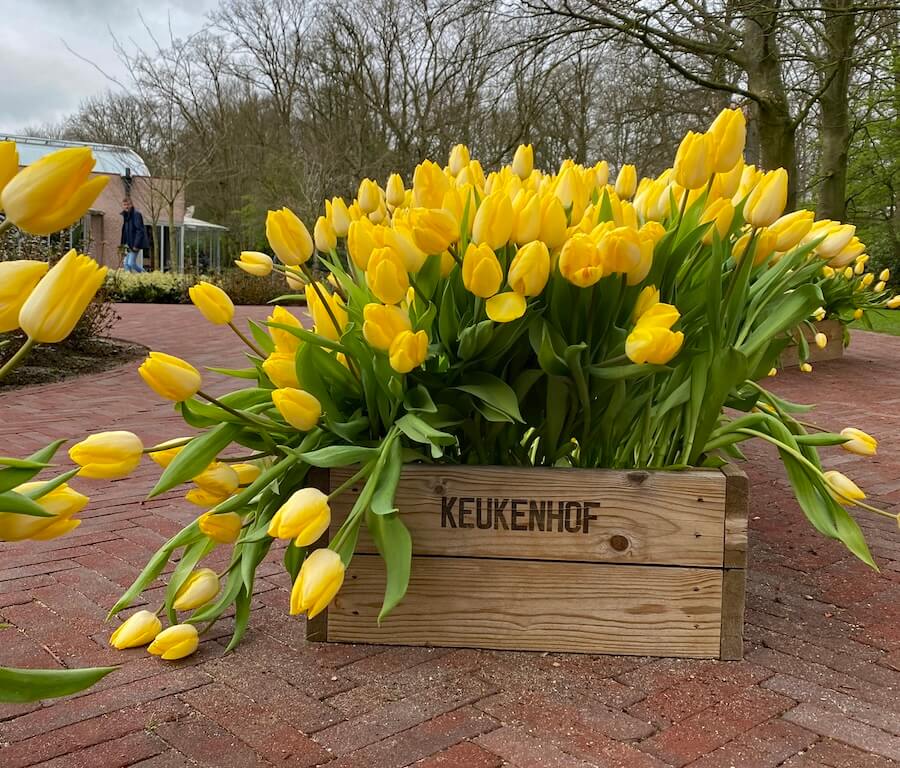
Crate of tulips at Keukenhof. * Photo: Katherine Rodeghier
Taming the Sea
Many of the crops in the Netherlands, tulips and otherwise, grow on land reclaimed from the North Sea. More than half of this country, which is about the size of Maryland, lies below sea level. Dikes and dams keep the water at bay.
I wanted to learn more about the process, so I took AmaSerena’s Delta Works excursion from the port in Middelburg. At a flood museum, we learned 1,836 people died when a winter storm surge in 1953 breached the barriers. Half a million acres were flooded with frigid seawater as much as 18 feet deep.
To prevent future catastrophes, the Delta Works construction project created a series of new dams, dikes, levees, locks and storm surge barriers. Begun in 1954 and completed in 1997, Delta Works was named one of the seven wonders of the modern world by the American Society of Civil Engineers.
To my dismay, the museum’s exhibits and our guide did little to explain the engineering behind the project. On our return to the ship, our tour bus merely drove over a dam with no behind-the-scenes look at its mechanicals. Back on board, several fellow passengers shared their disappointment.
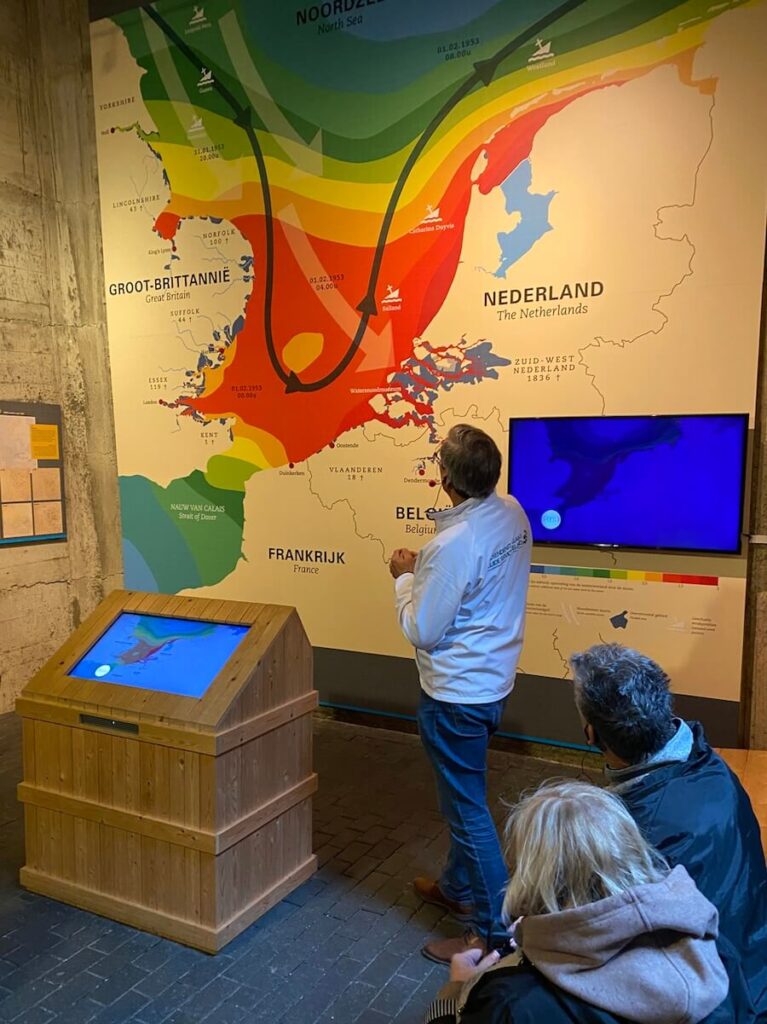
Passengers view exhibit at the flood museum. * Photo: Katherine Rodeghier
Biking on the Dikes
Passengers from Northern California, Rachel Bracamonte and Jeff Young, had a close look at these manmade barriers while biking atop dikes on an excursion from Hoorn.
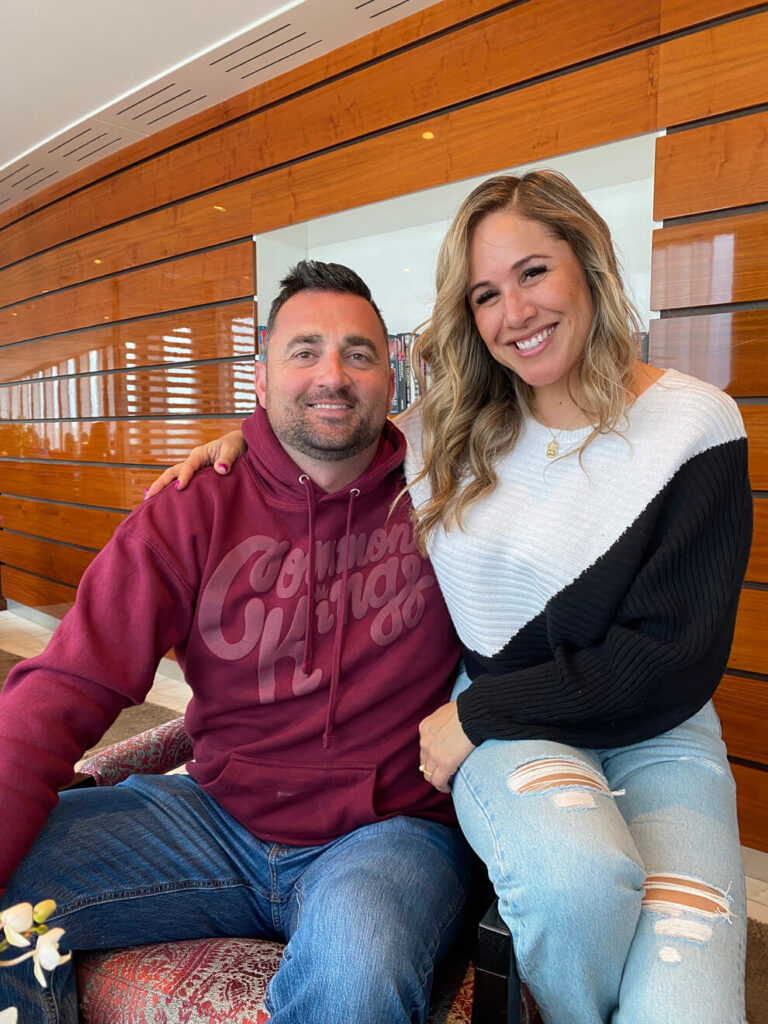
Biking passengers Jeff Young and Rachael Bracamonte. * Photo: Katherine Rodeghier
With water on one side and dry land on the other, Young told me about pedaling past houses and a dairy farm in the Zeeland countryside, stopping to look at a Beatles monument in the village of Blokker. Bracamonte said she enjoyed seeing cute Dutch houses with plants and trinkets displayed on the windowsills. Though there were few tulips, “I loved seeing houses with gardens and trees in bloom.”
AmaWaterways is known for its emphasis on biking. Tulip Time cruises have guided bike excursions from most ports or passengers may take a bike and set off on their own as well.
Helmets are required and passengers must sign a liability waiver. AmaSerena had 20 seven-speed city bikes. Wellness host Jovan Poznanovic led tours accompanied by a local guide.
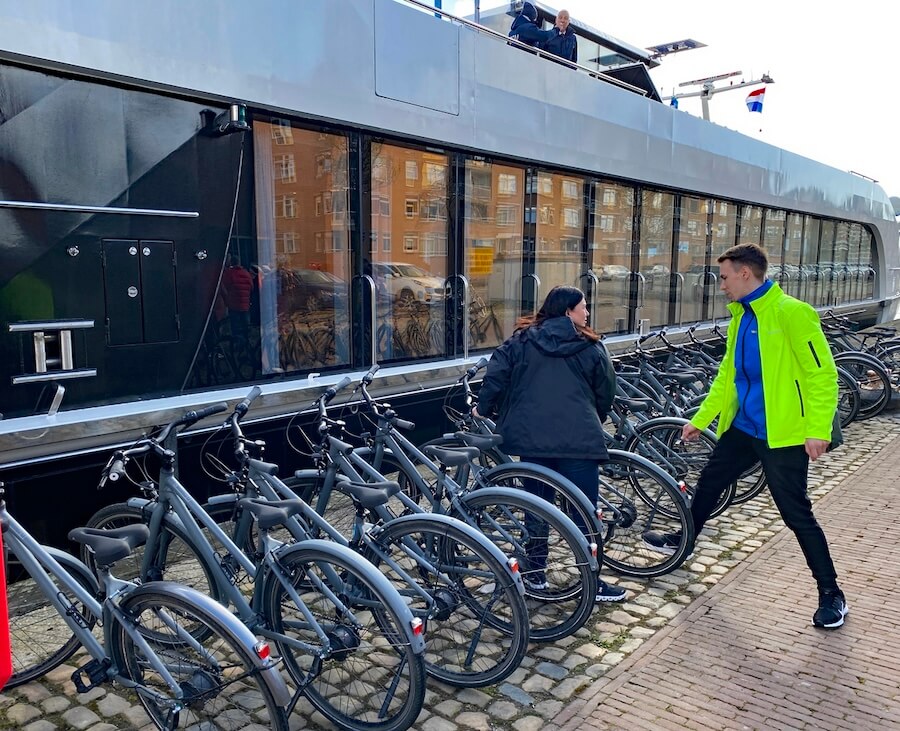
Wellness host Jovan Poznanovic with passenger and bikes. * Photo: Katherine Rodeghier
RELATED: Heidi reviews her AmaWaterways Dutch Waterways cruise that featured daily cycling.
AmaSerena Amenities
Paznanovic also led fitness classes in the lounge and on the sundeck, which has a putting green, lounge chairs, walking track, giant chess set and heated pool, though it was too cold for swimming this early in the cruise season.
Elsewhere, the ship had a fitness room, library, gift shop, hair styling and massage facilities.
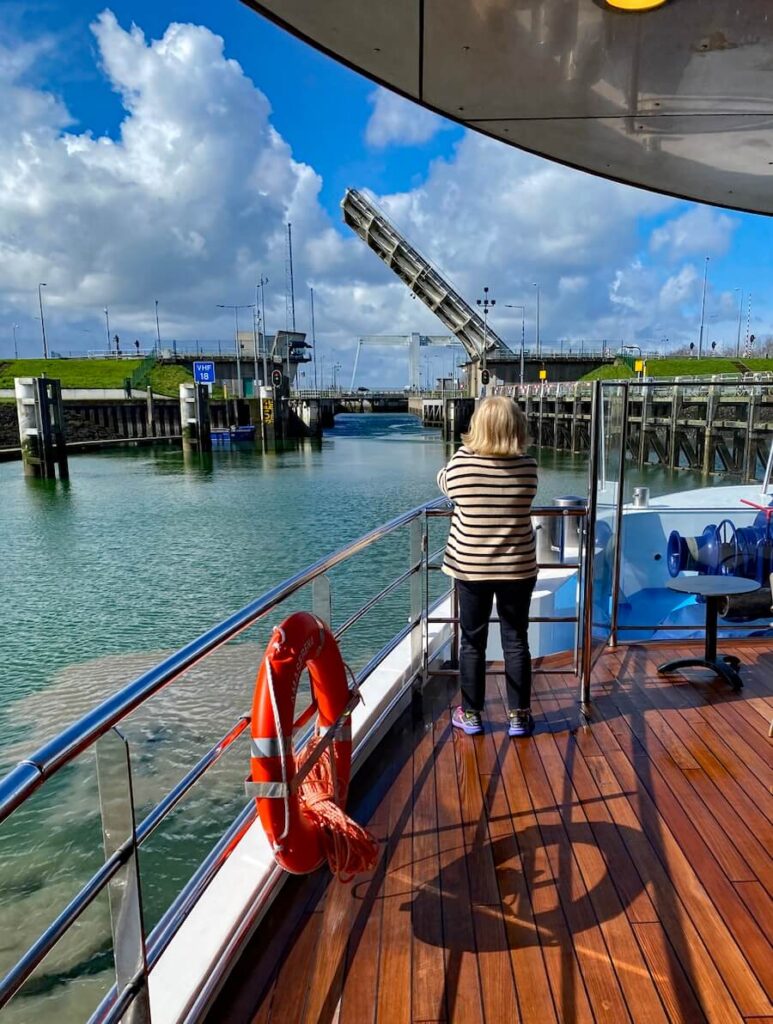
Passenger viewing a lock from the bow area of a lower deck. * Photo: Katherine Rodeghier
Captain Poppema told passengers who wanted to see the bridge to just knock on the door. If he wasn’t in a tricky navigation setting, such as going through a lock, we were welcome to enter. I did and he graciously showed off the nautical equipment and talked about his life growing up on Dutch cargo ships.
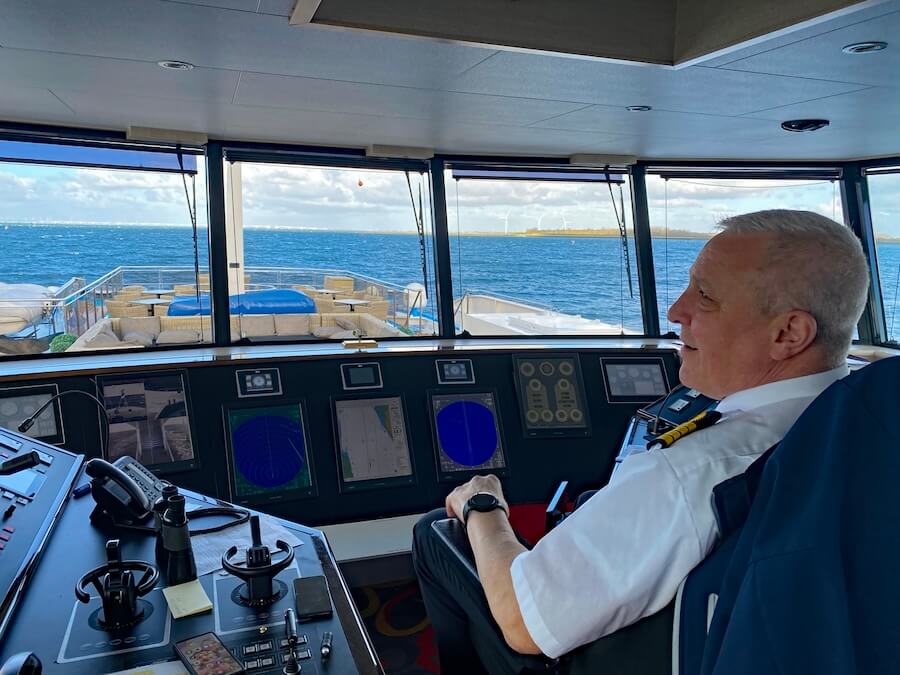
Captain Eddy Poppema on the bridge. * Photo: Katherine Rodeghier
His 35 years of experience proved crucial one night when a storm on the North Sea forced him to find an alternate route so the ship could arrive at the next day’s port on time.
Though AmaSerena has a capacity for 162 passengers, my early-season Tulip Time cruise had just 130 plus 51 crew.
Three decks house eight categories of staterooms. Mine, No. 316 in the mid-range BA category, had both an outdoor and French balcony, a white marble bathroom, flat-screen TV with a keyboard and thankfully reliable WiFi.
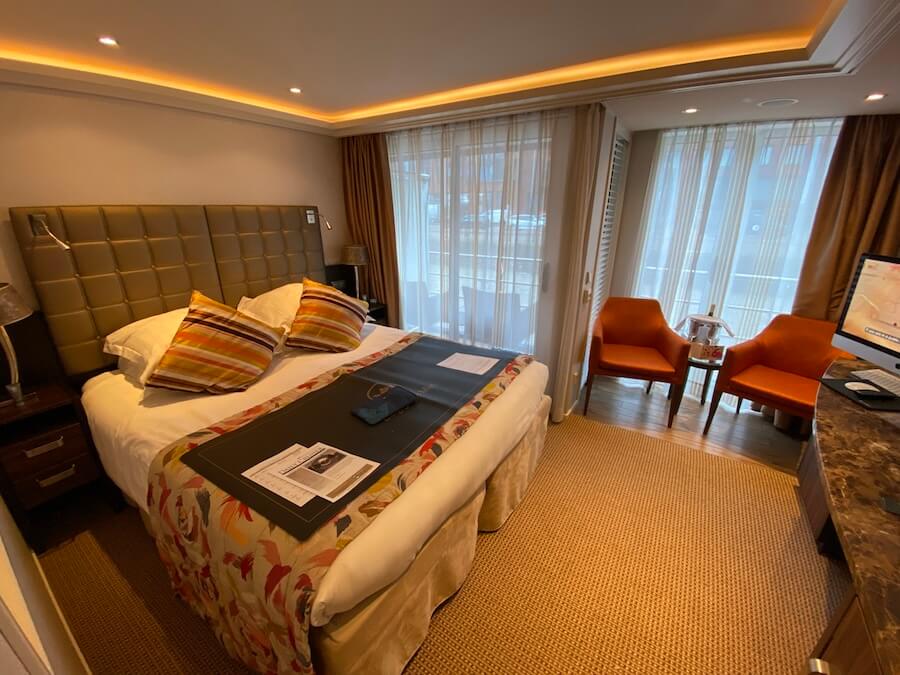
Writer’s stateroom 316. * Photo: Katherine Rodeghier
VIDEO: Below Kathy shows us around her cabin, #316.
Unlike on a previous AmaWaterways cruise, the ship’s daily program was not delivered nightly to my room but could be downloaded on a smartphone app that also contained the cruise itinerary, excursions and destination information.
All excursions were complimentary and divided into five activity levels plus three pace speeds for guided walks. On most excursions — not bike trips — individual audio devices helped passengers hear guides.
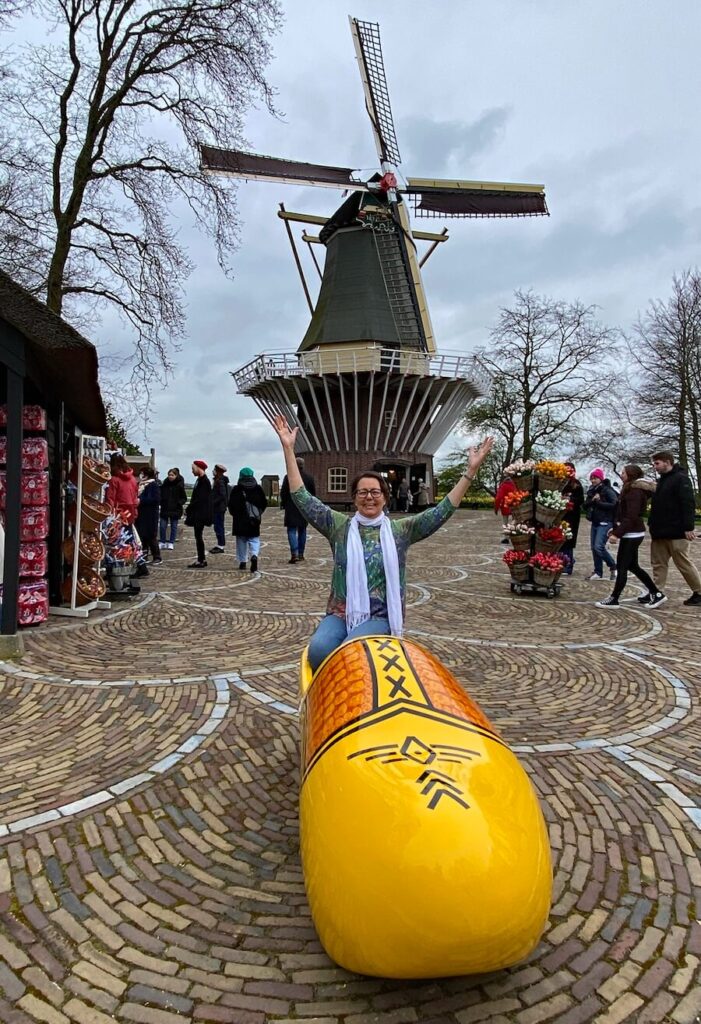
Writer Katherine Rodeghier on a tour, posing with a windmill and wooden shoe at Keukenhof. * Photo: Katherine Rodeghier
About the Food
It happened again. I disembarked from the cruise a few pounds heavier. Though I vowed not to overindulge on this cruise — and portions were reasonable — I couldn’t set my fork down.
Chef I Putu Krisna, who hails from Indonesia, prepared a mix of continental cuisine and local fare. One night I chose rack of lamb with crepes Suzette for dessert, another was branzino sea bass followed by Dutch pancakes and hazelnut ice cream.
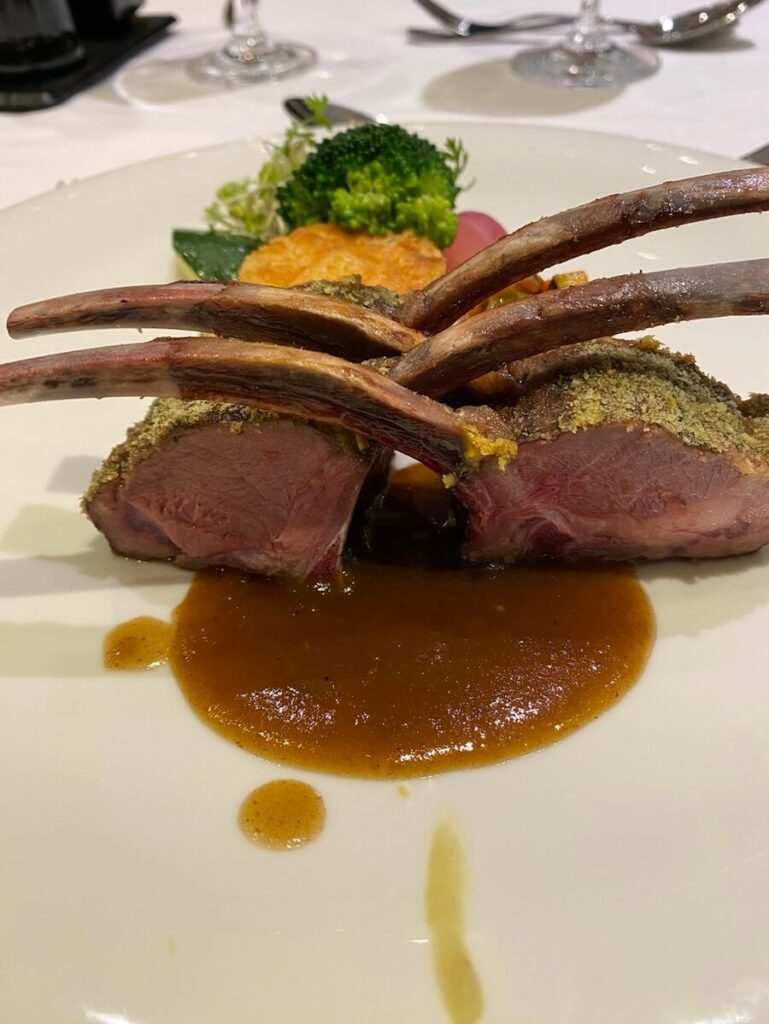
Lamb chops main restaurant. * Photo: Katherine Rodeghier

Chef I Putu Krisna preparing a dish for The Chef’s Table. * Photo: Katherine Rodeghier
At breakfast, I fell in love with avocado tartine, chef’s version of avocado toast. Breakfast was table service or a buffet with an omelet station.
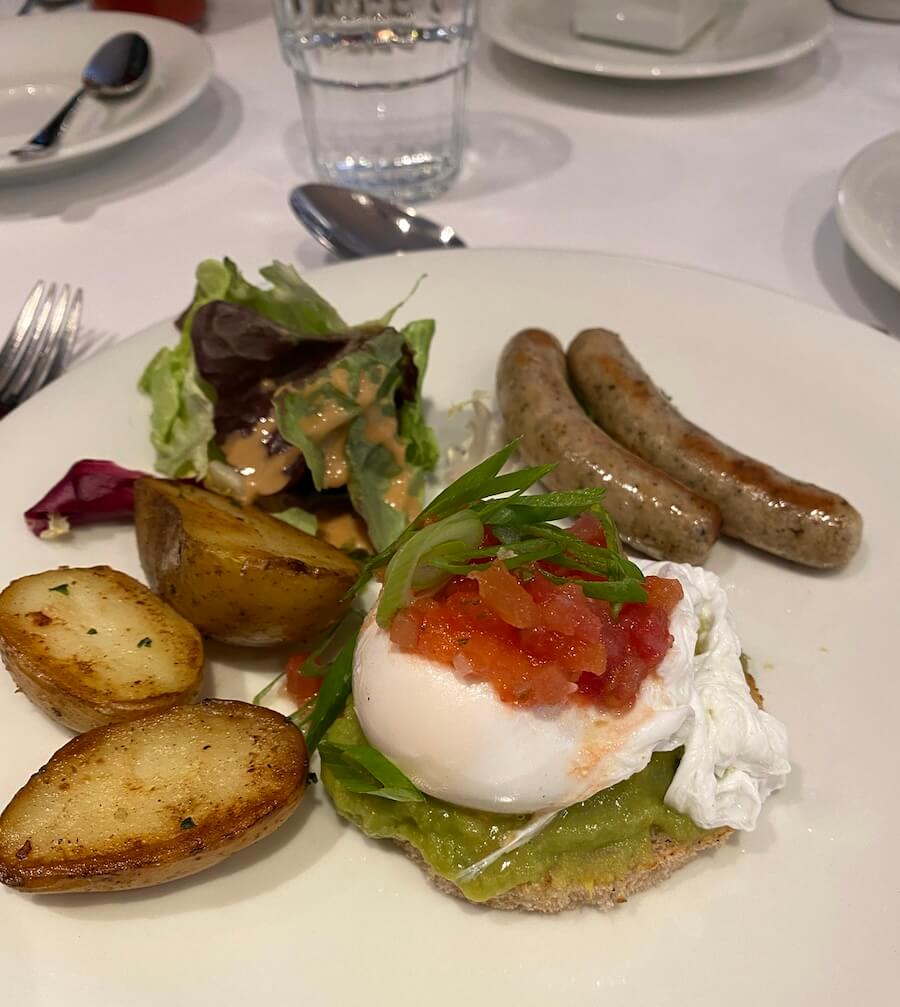
Avocado tartine breakfast entree. * Photo: Katherine Rodeghier
Lunches and dinners were multi-course with complimentary wine, beer and soft drinks. A self-serve coffee and tea station remained open all day outside the lounge where light meals often were available.
Evenings began with a cocktail hour in the bar followed by dinner with open seating in the main restaurant. The restaurant’s two wine cellar rooms often drew passengers who’d bonded on board to form new friend groups. Menus listed several choices, plus “always available” options such as steak and salmon. Care was given to passengers observing vegetarian, gluten-free and other special diets.
Reservations were required for my complimentary dinner in The Chef’s Table, a private dining room at the stern of the ship. Chef paired his seven-course tasting menu with white and red wines from Austria.
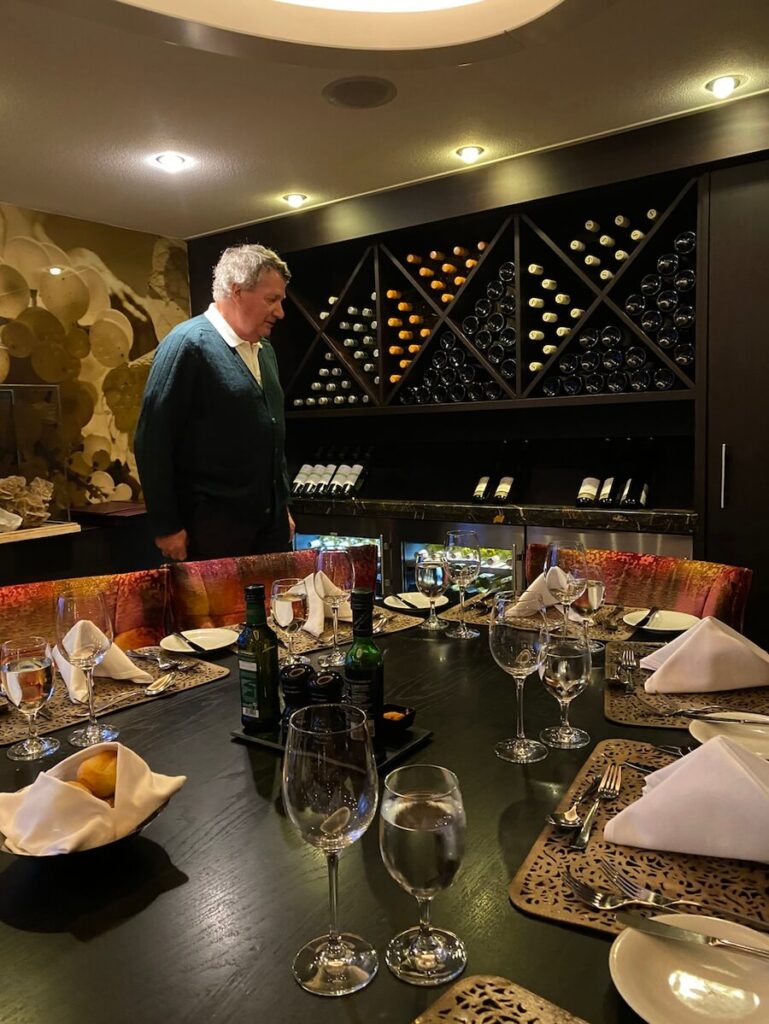
Wine cellar seating in main restaurant. * Photo: Katherine Rodeghier
What’s Included on an AmaWaterways Tulip Time Cruise
- Outside stateroom (balconies in most) with mini-fridge, internet access, movies and TV
- Wellness activities and exercise classes
- Entertainment; cultural performances
- All onboard meals with unlimited wine, beer and soft drinks with lunch and dinner; sparkling wine and fresh juice with breakfast
- Evening cocktail hours with wine, beer, spirits and soft drinks; tapas and snacks in the lounge
- All shore excursions
- Bicycles for guided tours and individual use
- Individual audio headsets
Belgian Cities
I indulged in more food on shore in Belgium. A tasting tour in Antwerp highlighted three of the country’s famous foods: chocolates at ChoFleur, a small shop 22 steps from the cathedral, beer at House of Beers where each brew has its own special glass, and waffles at House of Waffles where I learned these light, delicate treats are not eaten at breakfast but as an afternoon snack.
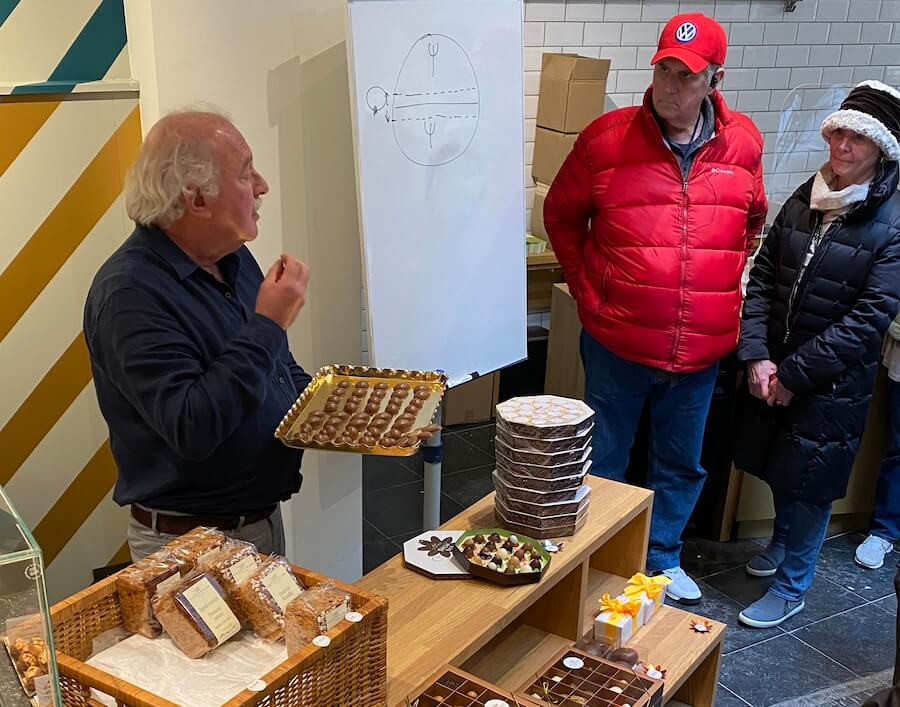
Sampling chocolates at ChoFleur in Antwerp. * Photo: Katherine Rodeghier
Walking tours in three Belgian cities were a whirlwind of castles, cathedrals and medieval architecture.
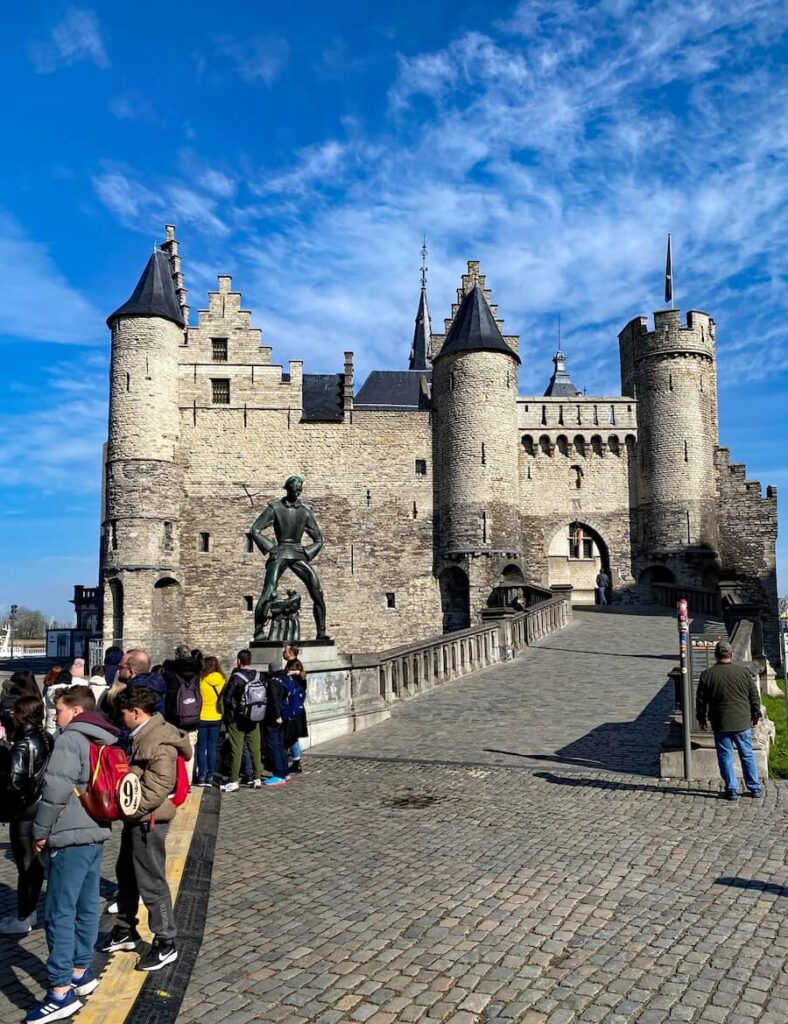
Het Steen Castle in Antwerp. * Photo: Katherine Rodeghier
Antwerp’s Het Steen Castle, dating from 1200, hugged the riverfront. In Grote Markt Square the Brabo Statue depicted a Roman centurion slaying a giant by chopping off his hand and head, an oft-told tale in Antwerp.
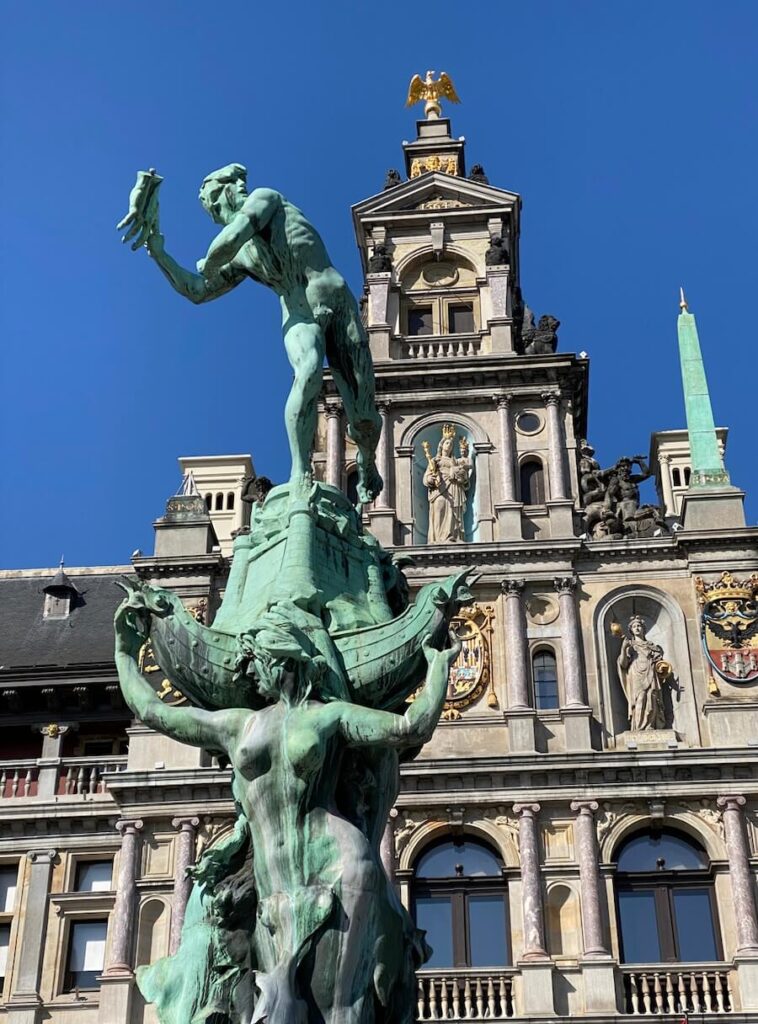
Antwerp city hall and Brabo Statue. * Photo: Katherine Rodeghier
I was charmed by Bruges with its horse-drawn carriages, cobblestone streets, canals and the daffodil-sprinkled grounds of a convent founded in 1245. Spared bombing during World War II, many buildings from the Middle Ages still stand making Bruges a UNESCO World Heritage Site.

Bruges Market Square. * Photo: Katherine Rodeghier
AmaSerena’s Cruise Manager Frederico Martinez warned passengers the full-day combination Bruges and Ghent tour would mean a lot of walking, so I spared my feet by spending my free time in Bruges lunching on waffles in a sun-filled café on Market Square.
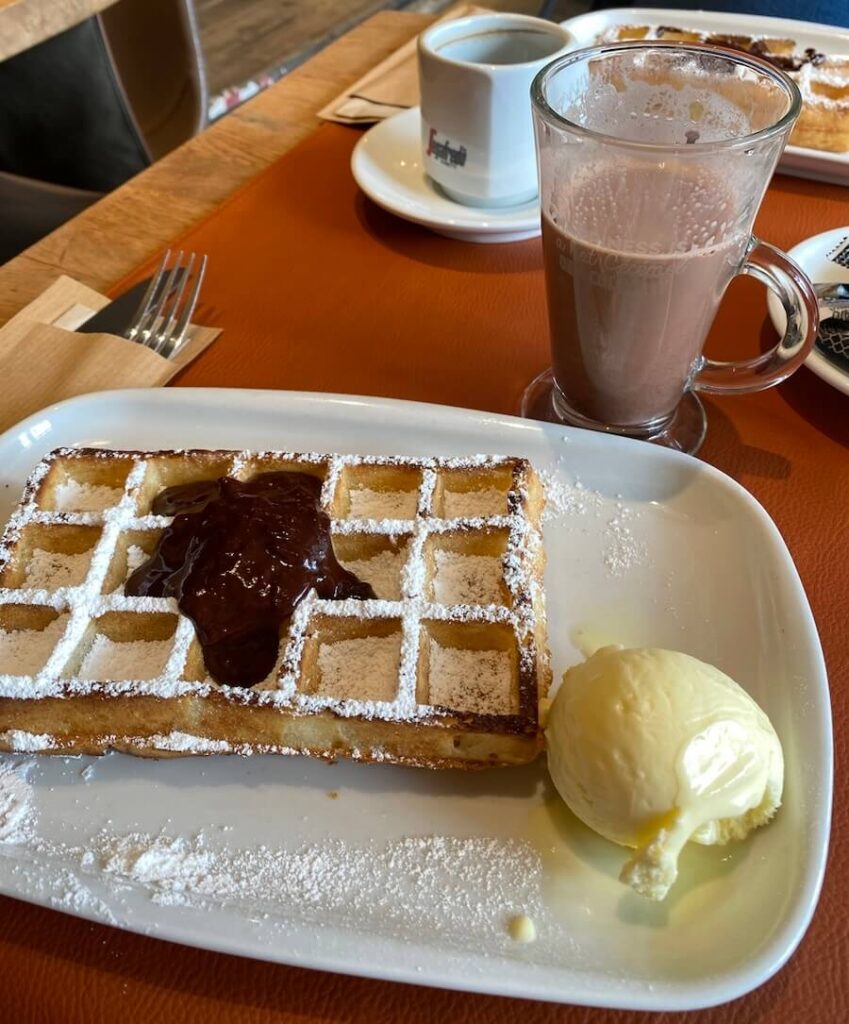
Belgian waffles at a Bruges cafe. * Photo: Katherine Rodeghier
Afterward in Ghent, I enjoyed seeing the Castle of the Counts and its cathedral with a spire taller than Notre Dame in Paris. By the end of the afternoon — and more than 17,000 steps — I had had enough touring. In hindsight, I would have skipped Ghent.
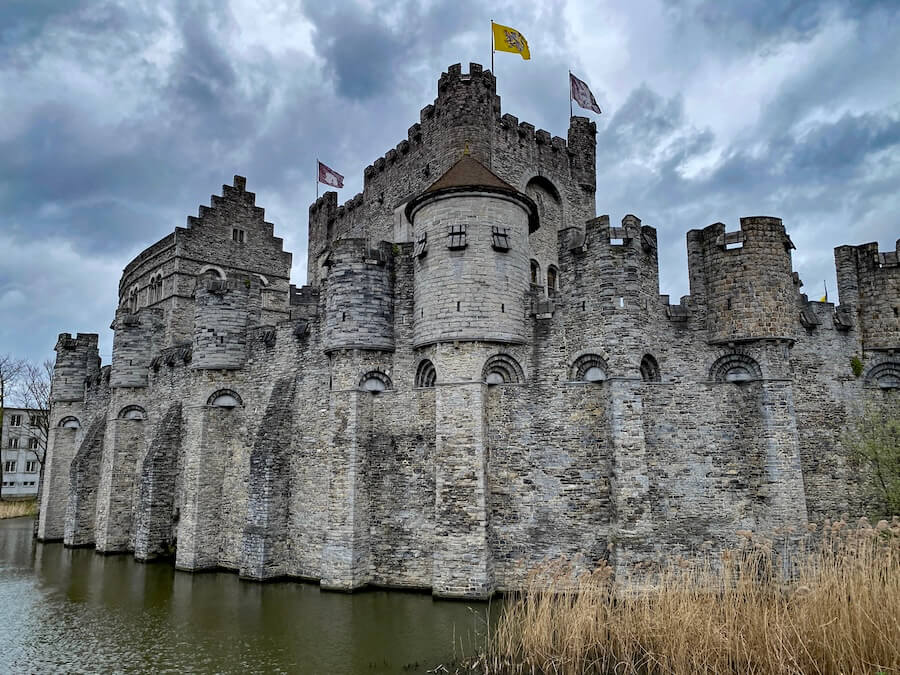
Ghent’s Castle of the Counts. * Photo: Katherine Rodeghier
Back to the Netherlands
Captain Poppema turned AmaSerena around, leaving Belgium to cruise overnight to Rotterdam. Unlike Bruges, this major European port was heavily bombed during World War II, so much of its architecture is modern, not medieval.
Its 58 bright yellow Cube Houses, the work of architect Piet Blom, reminded me of a field of tulips standing tall on their stems.
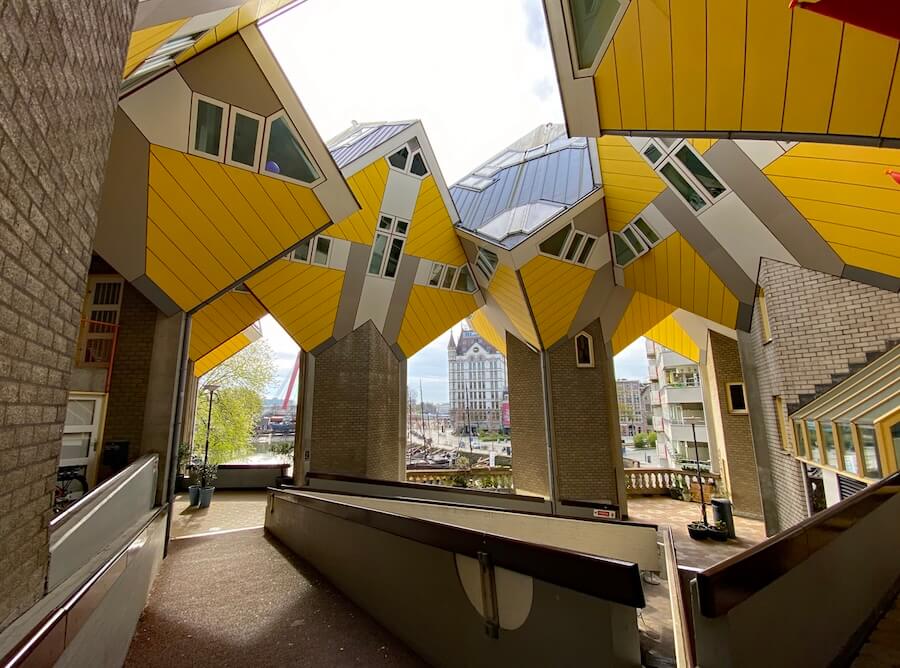
Cube Houses in Rotterdam. * Photo: Katherine Rodeghier
Inside Market Hall, shaped like an upside-down “U,” our tour group made the rounds of a food court, stopping to sample one of the Netherlands’ major exports: cheese.
Along with tulips, wooden shoes and colorful rounds of cheese, windmills are an iconic feature of the Netherlands. The country once had 13,000 windmills. Just 1,100 remain. I saw 19 on an excursion from Rotterdam to Kinderdijk, a UNESCO World Heritage site.
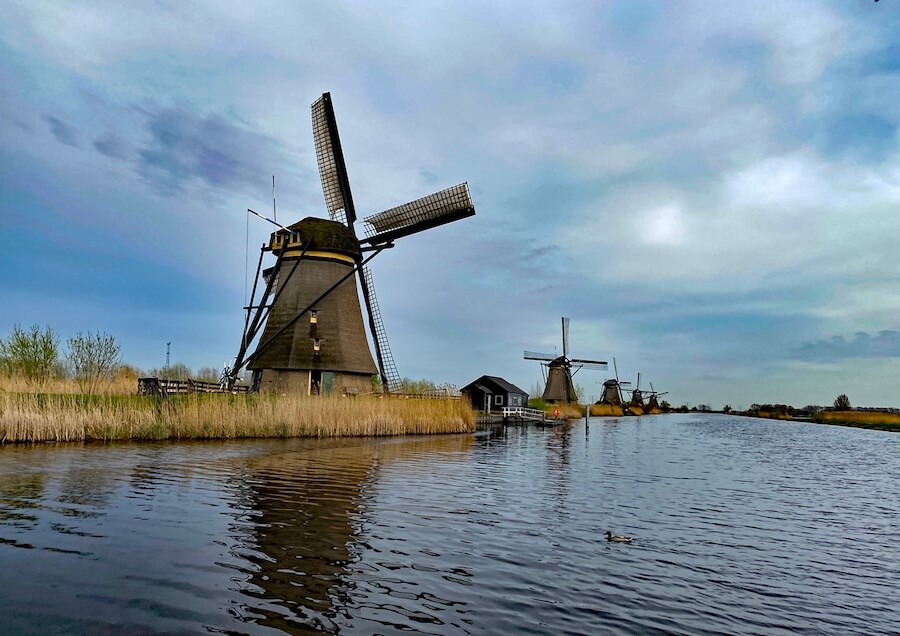
Kinderdijk windmills. * Photo: Katherine Rodeghier
The truth behind the popular saying, “God built the Earth, but the Dutch built the Netherlands,” was borne out when Kinderdijk guides explained how farmers drained land below sea level by using windmills to pump water out of ditches into canals.
Volunteer “millers” still operate Kinderdijk’s 18th-century windmills to keep them functioning. Some even inhabit them. Miller Adri van der Ent gave our group a tour of his windmill, including the cramped quarters inside. “My wife doesn’t want to live in the mill,” he said, “so I keep this as my man cave.”
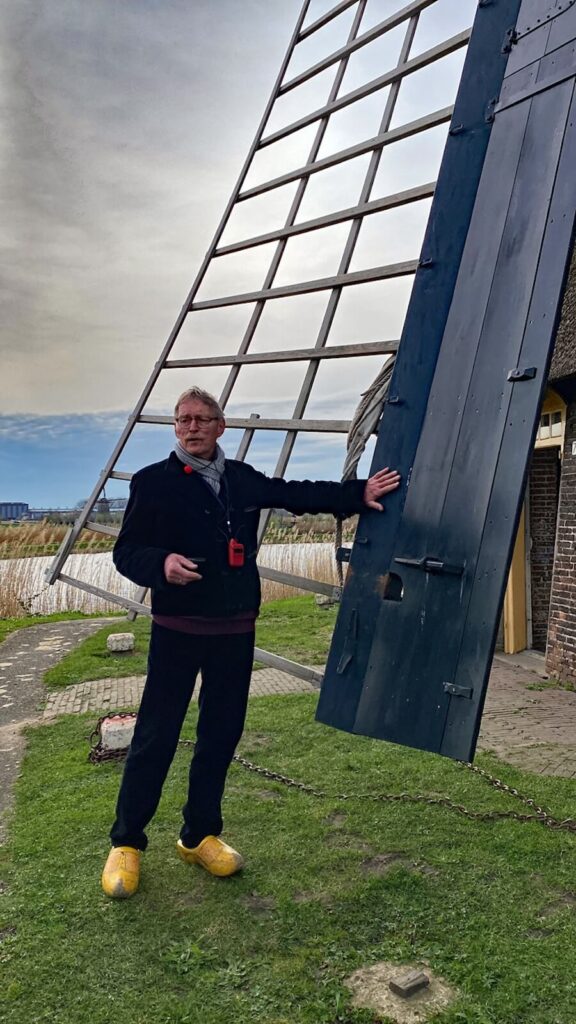
Kinderdijk miller Adri van der Ent. * Photo: Katherine Rodeghier
Tulip Time Cruise Quick Facts
- AmaWaterways seven-day Tulip Time cruises are offered from mid-March through early May.
- Tulip Times cruise fares start at $2,899 for early-season departures.
- Passengers fly into and out of Amsterdam Airport Schiphol.
- Give careful consideration to departure dates. Early-season cruises are less costly and crowded but temperatures often are colder and tulips may not be in bloom — except at Keukenhof.
- Weather in the Netherlands and Belgium is unpredictable and changes quickly. Early spring days may have scattered rain; highs in the 50s and low 60s.
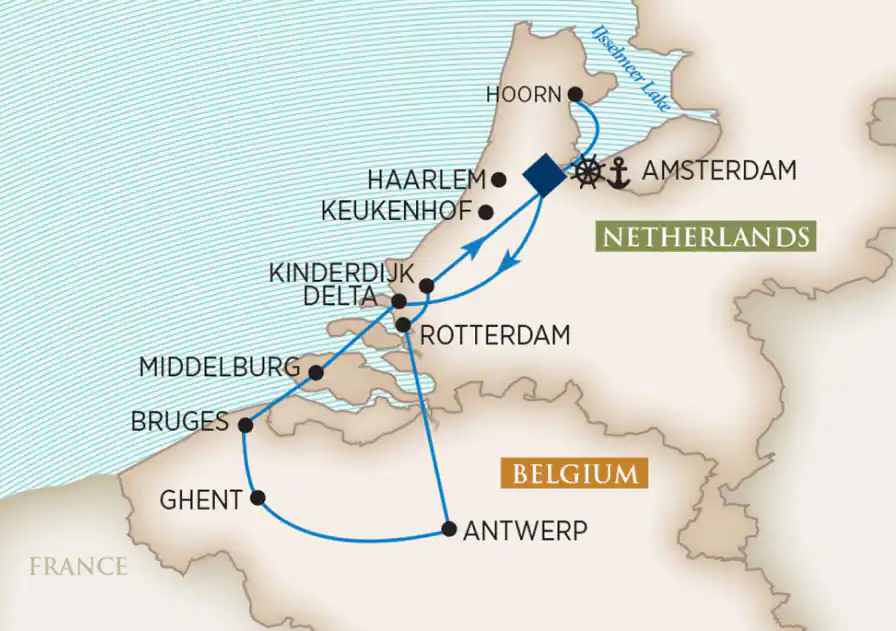
Tulip Time cruise route. * Map: AmaWaterways
Keukenhof Grand Final
I had another close look at a windmill, this one donated by Holland America Line next to Keukenhof’s bulb fields. Here visitors can buy tickets for a boat ride around the fields or they can pedal past them on bikes rented near the garden’s main entrance. This early in the season, though, the field tulips had yet to bloom so I did neither, and instead walked around the gardens to view the flower beds (where tulips were blooming).
Once the grounds of a castle belonging to a Bavarian countess, Keukenhof was founded in 1949 as a flower show with growers donating bulbs to show off their wares.
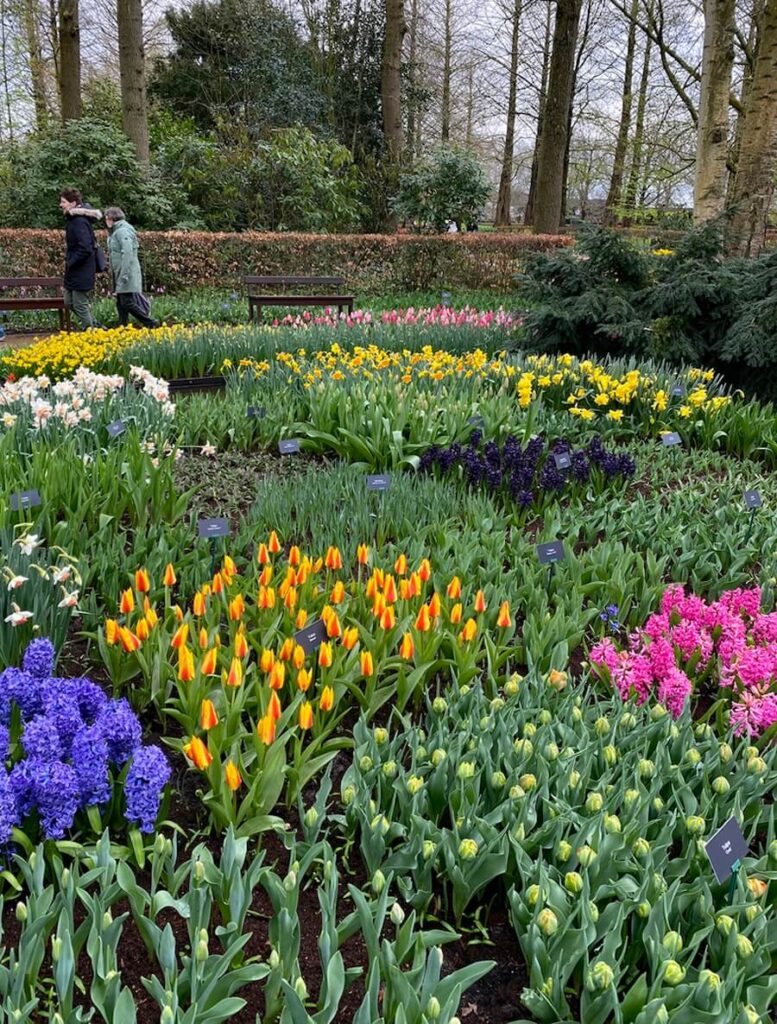
Keukenhof flower beds. * Photo: Katherine Rodeghier
Now in its 75th year, Keukenhof showcases 1,600 varieties of bulbs, 800 of them tulips, including one in its historical garden that dates back to 1595.
During its annual eight-week run from late March into May, 1.4 million visitors come from around the world to walk through the gardens, buy bulbs to ship home and browse pavilions named for members of the Dutch royal family.
For me, Keukenhof was the grand finale of my Tulip Time cruise, a last day spent gloriously immersed in the rainbow colors of my favorite flower.
Would I do it again? Yes, but I might consider a Tulip Time cruise later in the season — in April perhaps — but I wouldn’t consider any itinerary that didn’t include at least a half day at Keukenhof.
![]()
Don’t miss a post about small-ship cruising, subscribe to QuirkyCruise.com for monthly updates & special offers!
© This article is protected by copyright, no part may be reproduced by any process without written permission from the author. All Rights Reserved. QuirkyCruise.com.

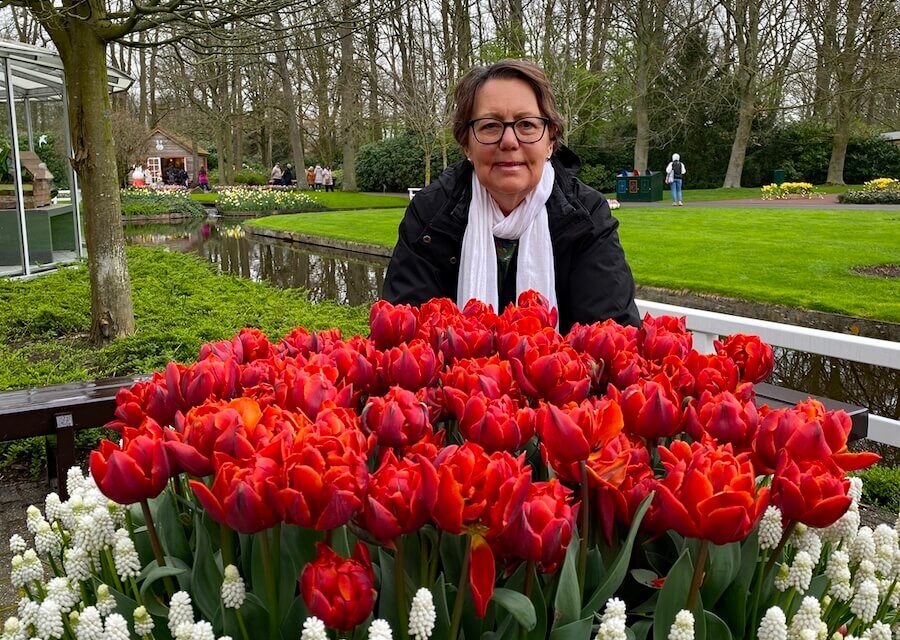
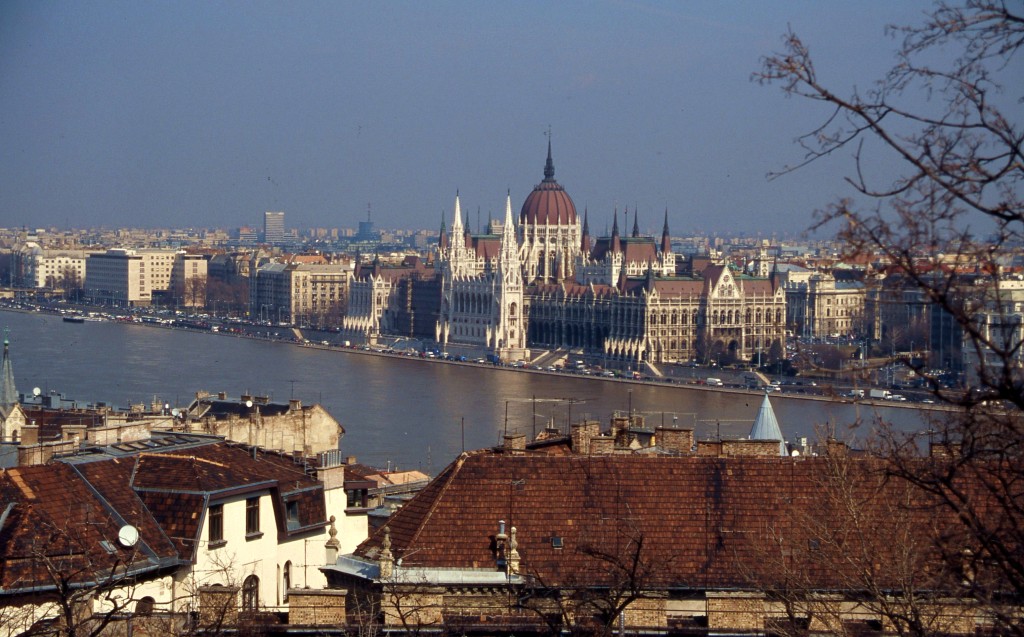


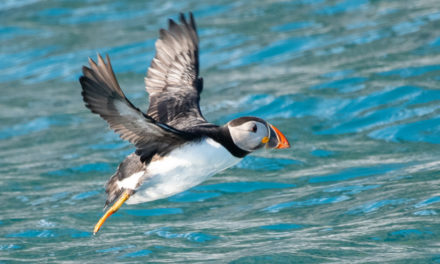








 HEIDI SARNA
HEIDI SARNA











